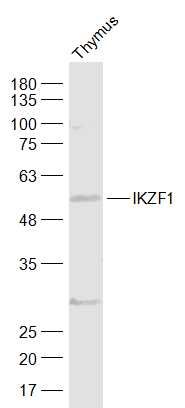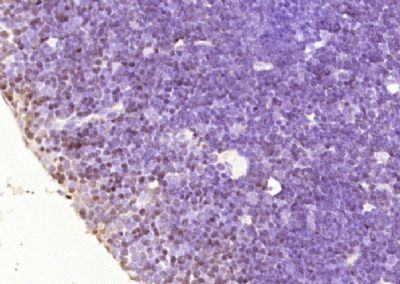This gene encodes a transcription factor that belongs to the family of zinc-finger DNA-binding proteins associated with chromatin remodeling. The expression of this protein is restricted to the fetal and adult hemo-lymphopoietic system, and it functions as a regulator of lymphocyte differentiation. Several alternatively spliced transcript variants encoding different isoforms have been described for this gene. Most isoforms share a common SLCterminal domain, which contains two zinc finger motifs that are required for hetero- or homo-dimerization, and for interactions with other proteins. The isoforms, however, differ in the number of N-terminal zinc finger motifs that bind DNA and in nuclear localization signal presence, resulting in members with and without DNA-binding properties. Only a few isoforms contain the requisite three or more N-terminal zinc motifs that confer high affinity binding to a specific core DNA sequence element in the promoters of target genes. The non-DNA-binding isoforms are largely found in the cytoplasm, and are thought to function as dominant-negative factors. Overexpression of some dominant-negative isoforms have been associated with B-cell malignancies, such as acute lymphoblastic leukemia (ALL). [provided by RefSeq, May 2014]
Function:
Transcription regulator of hematopoietic cell differentiation. Binds gamma-satellite DNA. Binds with higher affinity to gamma satellite A. Plays a role in the development of lymphocytes, B- and T-cells. Binds and activates the enhancer (delta-A element) of the CD3-delta gene. Repressor of the TDT (terminal deoxynucleotidyltransferase) gene during thymocyte differentiation. Regulates transcription through association with both HDASLCdependent and HDASLCindependent complexes. Targets the 2 chromatin-remodeling complexes, NuRD and BAF (SWI/SNF), in a single complex (PYR complex), to the beta-globin locus in adult erythrocytes. Increases normal apoptosis in adult erythroid cells. Confers early temporal competence to retinal progenitor cells (RPCs).
Subunit:
Heterodimer with other IKAROS family members. Interacts with IKZF4 AND IKZF5 (By similarity). Component of the chromatin-remodeling NuRD repressor complex which includes at least HDAC1, HDAC2, RBBP4, RBBP7, IKZF1, MTA2, MBD2, MBD3, MTA1L1, CHD3 and CHD4. Interacts directly with the CHD4 component of the NuRD complex. Component of the BAF (SWI/SNF) gene activator complex which includes ACTB, ARID1A, ARID1B, IKZF1, ARID1A, ARID1B, SMARCA2, SMARCA4 and at least one BAF subunit. Interacts directly with the SMARCA4 component of the BAF complex. Interacts with SUMO1; the interaction sumoylates IKAROS, promoted by PIAS2 and PIAS3. Interacts with PIAS2 (isoform alpha); the interaction promotes sumoylation and reduces transcription repression. Interacts, to a lesser extent, with PIAS3. Interacts with PPP1CC; the interaction targets PPP1CC to pericentromeric heterochromatin, dephosphorylates IKAROS, stabilizes it and prevents it from degradation. Interacts with IKZF3.
Subcellular Location:
Nucleus. Note=In resting lymphocytes, distributed diffusely throughout the Nucleus. Note=In resting lymphocytes, distributed diffusely throughout the nucleus. Localizes to pericentromeric heterochromatin in proliferating cells. This localization requires DNA binding which is regulated by phosphorylation / dephosphorylation events. Isoform Ik2: Nucleus. Note=In resting lymphocytes, distributed diffusely throughout the nucleus. Localizes to pericentromeric heterochromatin in proliferating cells. This localization requires DNA binding which is regulated by phosphorylation / dephosphorylation events. Isoform Ik6: Cytoplasm.
Tissue Specificity:
Abundantly expressed in thymus, spleen and peripheral blood Leukocytes and lymph nodes. Lower expression in bone marrow and small intestine.
Post-translational modifications:
Phosphorylation controls cell-cycle progression from late G(1) stage to S stage. Hyperphosphorylated during G2/M phase. Dephosphorylated state during late G(1) phase. Phosphorylation on Thr-140 is required for DNA and pericentromeric location during mitosis. CK2 is the main kinase, in vitro. GSK3 and CDK may also contribute to phosphorylation of the SLCterminal serine and threonine residues. Phosphorylation on these SLCterminal residues reduces the DNA-binding ability. Phosphorylation/dephosphorylation events on Ser-13 and Ser-295 regulate TDT expression during thymocyte differentiation. Dephosphorylation by protein phosphatase 1 regulates stability and pericentromeric heterochromatin location. Phosphorylated in both lymphoid and non-lymphoid tissues.
Sumoylated. Simulataneous sumoylation on the 2 sites results in a loss of both HDASLCdependent and HDASLCindependent repression. Has no effect on pericentromeric heterochromatin location. Desumoylated by SENP1.
Polyubiquitinated.
DISEASE:
Note=Defects in IKZF1 are frequent occurrences (28.6%) in acute lymphoblasic leukemia (ALL). Such alterations or deletions lead to poor prognosis for ALL.
Similarity:
Belongs to the Ikaros C2H2-type zinc-finger protein family.
Contains 6 C2H2-type zinc fingers.
SWISS:
Q13422
Gene ID:
1064
Database links:
Entrez Gene: 395974 Chicken
Entrez Gene: 1064 Human
Entrez Gene: 22778 Mouse
Omim: 603023 Human
SwissProt: O42410 Chicken
SwissProt: Q13422 Human
SwissProt: Q03267 Mouse
Unigene: 435949 Human
Unigene: 488251 Human
Unigene: 103545 Mouse
| Picture |
Sample:
Thymus (Mouse) Lysate at 40 ug
Primary: Anti-IKZF1 (SL8172R) at 1/1000 dilution
Secondary: IRDye800CW Goat Anti-Rabbit IgG at 1/20000 dilution
Predicted band size: 57 kD
Observed band size: 57 kD
Paraformaldehyde-fixed, paraffin embedded (mouse thymus); Antigen retrieval by boiling in sodium citrate buffer (pH6.0) for 15min; Block endogenous peroxidase by 3% hydrogen peroxide for 20 minutes; Blocking buffer (normal goat serum) at 37°C for 30min; Antibody incubation with (IKZF1,DNA-binding protein Ikaros) Polyclonal Antibody, Unconjugated (SL8172R) at 1:200 overnight at 4°C, followed by operating according to SP Kit(Rabbit) (sp-0023) instructionsand DAB staining.
|
|
|

